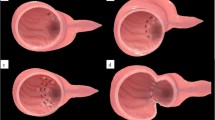Summary
Mechanical suturing has become widespread in Italy in recent years, especially for anastomoses between the large intestines and the rectum and between the esophagus and the stomach or small intestine; many chest surgeons also use this type of suture. Basically, mechanical suturing is preferred for anastomoses for which the manual technique has proved difficult, for example those low in the pelvis or high up in the chest. Few surgeons use mechanical suturing at sites where it is easy to suture by hand. Overall, experience with mechanical suturing has been positive, mainly because the number of conservative resections performed for rectal carcinoma has increased while the frequency of the so-called Miles operation has declined in recent years. Our own experience with mechanical suturing has been collected in the construction of colorectal (235 with mechanical suturing out of a total of 592), ileorectal and ileoanal anastomoses (45 ileorectal and 12 ileoanal anastomoses with mechanical suturing out of a total of 155 surgical operations).
Zusammenfassung
In Italien hat sich die Maschinennaht in den letzten Jahren weitgehend verbreitet, vor allem für Anastomosen zwischen Dickdarm und Rectum, Speiseröhre und Magen oder Dünndarm, während viele Chirurgen in der Thoraxchirurgie diese Art Naht reichlich gebrauchen. Grundsätzlich zieht man die Maschinennaht für die Anastomosen vor, für die die manuelle Ausführung sich als schwer erweist, wie zum Beispiel die Suturen tief im Pelvis oder hoch im Thorax. Nur wenige Chirurgen benutzen die Maschinennaht, wenn die manuelle Anastomose leicht ist. Die gesamte Erfahrung ist günstig, vor allem weil die Zahl der konservativen Resektionen für Rectumkrebs höher geworden ist, während die Zahl der sogenannten “Miles”-Operationen in den letzten Jahren eine Verringerung aufgewiesen hat. Die persönliche Erfahrung (der gesamte italienische Beitrag wird im Laufe des Kongresses mitgeteilt werden) ist folgende: 235 mechanische colorectale Anastomosen (592 operierte Fälle insgesamt), 45 mechanische ileorectale Anastomosen und 12 mechanische ileo-anale Anastomosen (155 operierte Fälle insgesamt).
Similar content being viewed by others
Author information
Authors and Affiliations
Rights and permissions
About this article
Cite this article
Fegiz, G. 13. Manuelle Naht versus/sive Maschinennaht (aus der Sicht Italiens). Langenbecks Arch Chiv 372, 93–97 (1987). https://doi.org/10.1007/BF01297797
Issue Date:
DOI: https://doi.org/10.1007/BF01297797




